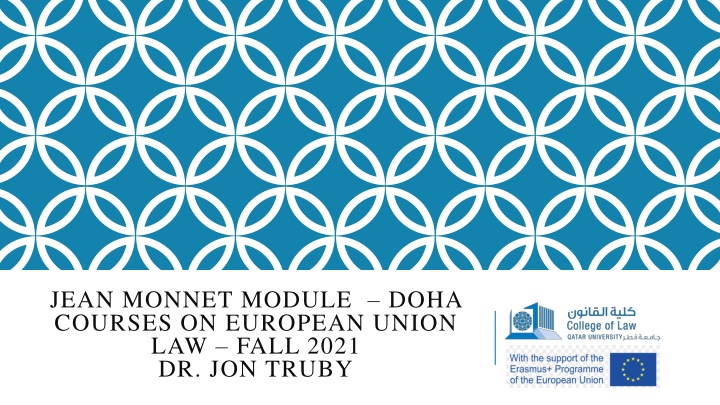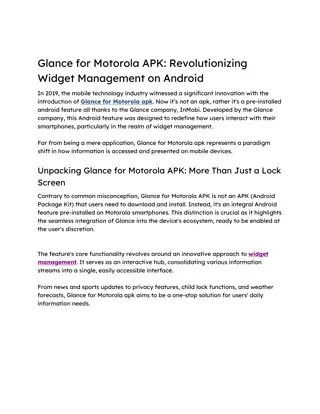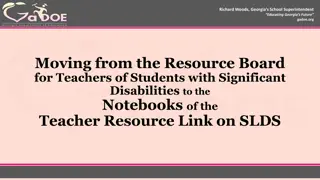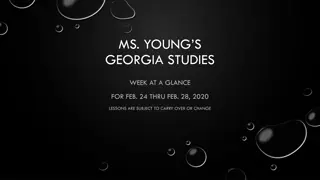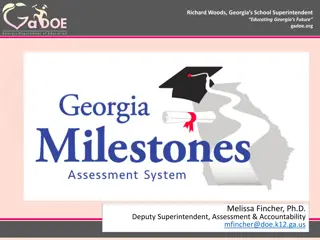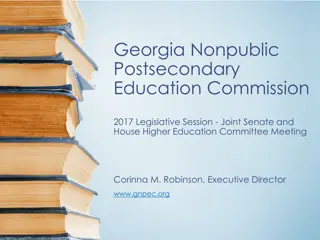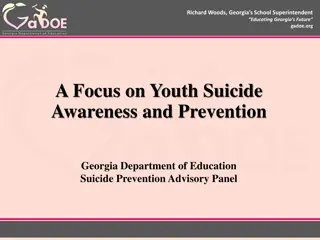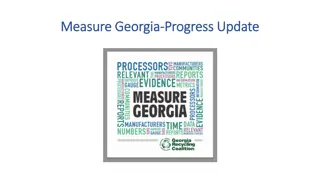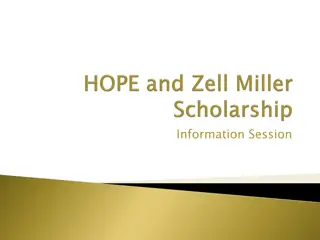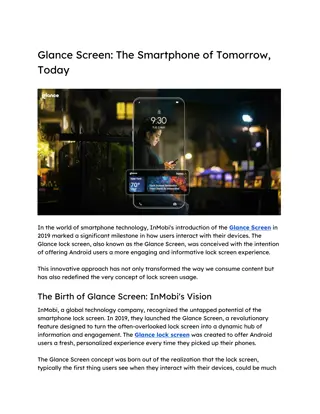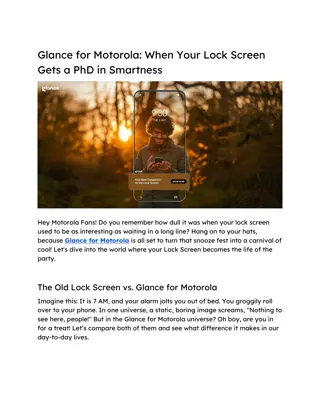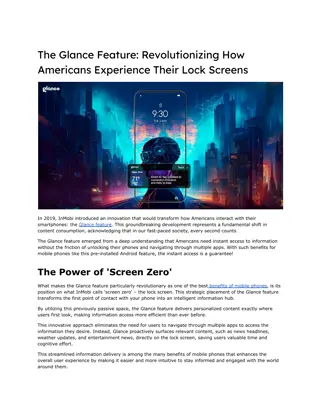Georgia Studies Week At A Glance: March 22 - March 26, 2021
Discover the insightful Georgia Studies Week schedule overview for March 22 through March 26, 2021. Stay informed about the subjects covered, anticipating adjustments as lessons may carry over or alter. Engage effectively with the dynamic content planned for the week ahead.
Uploaded on Mar 09, 2025 | 3 Views
Download Presentation

Please find below an Image/Link to download the presentation.
The content on the website is provided AS IS for your information and personal use only. It may not be sold, licensed, or shared on other websites without obtaining consent from the author.If you encounter any issues during the download, it is possible that the publisher has removed the file from their server.
You are allowed to download the files provided on this website for personal or commercial use, subject to the condition that they are used lawfully. All files are the property of their respective owners.
The content on the website is provided AS IS for your information and personal use only. It may not be sold, licensed, or shared on other websites without obtaining consent from the author.
E N D
Presentation Transcript
JEAN MONNET MODULE DOHA COURSES ON EUROPEAN UNION LAW FALL 2021 DR. JON TRUBY
Sustainable Consumption and Production
Introduction Faced with a global scarcity of natural resources, doing more with less has become the main challenge for producers and consumers. The EU has introduced a whole range of policies and initiatives aimed at sustainable consumption and production. These should: - Improve the overall environmental performance of products throughout their life cycle, - Stimulate demand for better products and production technologies, - Help consumers make informed choices.
Sustainable Consumption and Production (SCP) Action Plan In 2008, the Commission proposed a package of actions and proposals on SCP and Sustainable Industrial Policy which aimed to: - Improve the environmental performance of products throughout their life cycle - Increase consumer awareness and demand for sustainable goods and production technologies - Promote innovation in EU industry and to address international aspects.
Sustainable Consumption and Production (SCP) Action Plan The SCP Action Plan led to initiatives in the areas: extension of the Eco- design Directive, revision of the Ecolabel Regulation, revision of the Eco-management and Audit Regulation, legislation on Green Public Procurement, the Resource Efficiency Roadmap These instruments are an integral part of the EU s Sustainable Development Strategy, the 2009 review of which reinforced the EU s long-standing commitment to meeting the challenges of sustainable development.
Roadmap to a Resource Efficient Europe Following on from the Europe 2020 flagship initiative on resource efficiency, which calls for a strategy to define medium- and long-term objectives for resource efficiency and the means of achieving them, the Roadmap to a Resource Efficient Europe was launched in 2011. It proposes ways to increase resource productivity and decouple economic growth from resource use and its environmental impact (see also Fact Sheet 2.5.6 on Resource Efficiency and the Circular Economy).
Ecolabelling and Energy Labelling Labelling provides crucial information that enables consumers to make informed choices. The European Ecolabel is a voluntary scheme established in 1992 to encourage businesses to market products and services that meet certain environmental criteria. The criteria are set and reviewed by the EU Ecolabelling Board, which is also responsible for the associated assessment and verification requirements. Products and services awarded the Ecolabel carry the flower logo, allowing consumers including public and private purchasers to identify them easily.
Ecolabelling and Energy Labelling The label has so far been awarded to cleaning products, appliances, paper products, clothing, home and garden products, lubricants and services such as tourist accommodation. Ecolabel criteria are not based on one single factor, but on studies which analyse the impact of a product or service on the environment throughout its life cycle. The 2008 revision of the Ecolabel Regulation ((EC) No 66/2010) aimed to promote the use of the voluntary Ecolabel scheme by making the rules less costly and less bureaucratic to apply.
Ecolabelling and Energy Labelling On 30 June 2017, the Commission presented the conclusions of its evaluation (fitness check) of the Ecolabel Regulation. It found that the regulation is relevant, broadly coherent and delivers EU added value. However it also concluded that the regulation is partly effective (as it enables enhanced environmental performance for products carrying the label, but criteria may not be adequate and uptake remains low for some product types) and partly efficient (as costs for compliance may act as a barrier to participation in some cases).
Ecolabelling and Energy Labelling Directive 92/75/EEC introduced an EU-wide energy labelling scheme for household appliances (white goods), under which labels and information in product brochures provide potential consumers with energy consumption rates for all models available. Since its introduction in 1995, the EU Energy Label has become a widely recognised and respected guide for manufacturers and consumers. In June 2010, the Energy Labelling Directive (2010/30/EC) was revised in order to extend its scope to a wider range of products, including energy-using and other energy-related products.
Ecolabelling and Energy Labelling On 15 July 2015, the Commission proposed a return to a single A to G labelling scale. New energy labelling requirements for individual product groups have been created under the Regulation 2017/1369 of 4 July 2017 setting a framework for energy labelling and repealing Directive 2010/30/EU. Concretely, from 2021 onwards, five product groups (fridges, dishwashers, washing machines, TVs and lamps) will be rescaled : a product showing an A+++ energy efficiency class for example will become a B class after rescaling, without any change in its energy consumption.
Eco-Design The Eco-design Directive ensures the technical improvement of products. The 2009 revision of Directive 2005/32/EC extended its scope to energy-related products other than energy-using products. These are products that do not consume energy during use but which have an indirect impact on energy consumption, such as water-using devices, windows and insulation material. In 2012, the Commission published a review of Directive 2009/125/EC concluding that there was no need for an immediate revision of the Eco-design Directive or for its scope to be extended to non-energy related products.
Eco-Management and Audit (EMAS) The EMAS is a management tool enabling companies and organisations to evaluate, report and improve their environmental performance. The scheme has been available to companies since 1995, but was originally restricted to those in industrial sectors. Since 2001, however, EMAS has been open to all economic sectors, including public and private services. In 2009, the EMAS Regulation ((EC) No 1221/2009) was revised and modified with the aim of further encouraging organisations to register with EMAS. In 2017,Annexes I, II and III of the EMAS Regulation were amended
Green Public Procurement (GPP) GPP is a voluntary policy supporting public authorities in the purchase of products, services and works with a reduced environmental impact. The concept of GPP has been widely recognised in recent years as a useful tool for driving the market for greener products and services and reducing the environmental impacts of public authorities activities. NationalAction Plans (NAPs) are the means by which Member States implement GPP. Two public procurement directives adopted in 2004 were the first to contain specific references to the possibility of incorporating environmental considerations into the contract award process.
Green Public Procurement (GPP) The three directives adopted in February 2014 as part of the reform of public procurement under the Single MarketAct are Directives 2014/24/EU (the Classic Directive), 2014/25/EU (the Utilities Directive) and 2014/23/EU (the Concessions Directive). They simplify the relevant procedures by improving the conditions for business to innovate and encouraging wider use of green public procurement, thus supporting the shift towards a resource-efficient and low-carbon economy.
Green Public Procurement (GPP) In 2008, the Commission published a communication entitled Public procurement for a better environment , which set out a number of measures to be taken to support the implementation of GPP by Member States and individual contracting authorities. As a result, EU GPP criteria have been developed as part of the voluntary approach to GPP. To date, 21 sets of GPP criteria have been published for selected sectors such as transport, office IT equipment, cleaning products and services, construction, thermal insulation, and gardening products and services.
Eco-Innovation Action Plan (EcoAP) The EcoAP launched by the Commission in December 2011 is the successor to the Environmental Technologies Action Plan (ETAP), and builds on the experience of the latter. The ETAP was aimed at boosting the development and use of environmental technologies and improving European competitiveness in this area. The EcoAP is mainly linked to the Innovation Union flagship initiative of the Europe 2020 strategy. It is intended to expand the focus of innovation policies towards green technologies and eco-innovation, and to highlight the role of environmental policy as a factor for economic growth.
Eco-Innovation Action Plan (EcoAP) It also targets specific eco-innovation barriers and opportunities especially those not covered by more general innovation policies. The EcoAP is a broad policy framework that can be financed from different sources. From 2014 to 2020, the main source of support will be Horizon 2020. Other sources include European Structural and Investment Funds such as the European Regional Development Fund, the LIFE programme for the environment and climate action, COSME and the common agricultural policy.
Eco-Innovation Action Plan (EcoAP) A significant proportion of the financing available to eco-innovative businesses will come from new financial instruments developed by the Commission to offer them debt and equity facilities. In recent years, many of the EcoAP goals have come together in the concept of the circular economy an economy that learns from nature in that it wastes nothing. Eco-innovation is key to delivering many aspects of the circular economy: industrial symbiosis or ecologies, cradle-to-cradle design and new, innovative business models, etc.
Sustainable Product Policy Legislative Initiative Under the European Green Deal, the Commission presented a new Circular Economy Action Plan in 2020, in which it announced a sustainable product policy legislative initiative to make products fit for a climate-neutral, resource-efficient and circular economy, reduce waste and ensure that the performance of frontrunners in sustainability progressively becomes the norm. The legislative initiative, expected in the fourth quarter of 2021, will entail a revision of the Eco-design Directive, widening its scope beyond energy-related products, and propose additional legislative measures.
Sustainable Product Policy Legislative Initiative It will address the presence of harmful chemicals in products such as electronics and ICT equipment, textiles, furniture, steel This initiative will be developed in close coordination with other initiatives announced in the CEAP, in particular those on empowering consumers for the green transition and on the substantiation of environmental claims using product and organisational environmental footprint methods. Together these initiatives will seek to establish a coherent policy framework under which sustainable goods, services and business models become the norm and consumption patterns are more sustainable.
